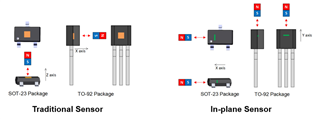Hall-effect switches are simple position sensing solutions, which indicate the presence or absence of a magnet, and can be used in a variety of different applications across the market. You can imagine the endless amount of electromechanical systems these sensors are expected to fit into that alter the device selection criteria, such as magnetic characteristics, power consumption, package type and size. However, one particular feature that isn’t discussed enough is the axis of sensitivity.
Traditionally, Hall-effect switches are offered in SOT-23 and TO-92 packages with a Hall sensing element that’s sensitive to magnetic fields perpendicular to the face of the IC package. Although the traditional Hall switches are suitable for a variety of applications, there are cases where it’s beneficial to have a planar or in-plane sensor that is sensitive to magnetic fields parallel to the face of the IC package. See Figure 1 below for a side-by-side comparison of the traditional and in-plane sensor.

Figure 1: Comparing Direction of Sensitivity of Traditional and In-plane Sensors
Before discussing the benefits of an in-plane Hall switch, we’ll quickly cover the different market terminologies used for this device to avoid any confusion. In-plane Hall-effect switches can also be referred to as vertical Hall-effect switches or lateral Hall-effect switches. The term vertical comes from the vertical Hall sensing element within the device, and similar to planar or in-plane, lateral refers to the ability to detect magnetic fields that come from the side of the package.
Now getting back to the advantages of a planar Hall switch. For systems with limited spacing, the device package and/or the direction the magnet approaches the sensor become important factors to consider for design. Lateral sensors can aid in overcoming mechanical limitations by allowing the magnet to approach the SOT-23 or TO-92 packages from directions not supported by the traditional sensors. Not only does this increase placement options, it can also reduce size and save overall system cost. The TMAG5123 is TI’s first in-plane Hall-effect switch with high precision and a wide operating voltage range from 2.5V to 38V.
With the ability to detect parallel magnetic fields, Hall sensors can now be used in place of other technologies. Some of the most common technologies seen in this space are mechanical switches, xMR devices, and reed switches. For more information about vertical Hall-effect switches and how they compare to other technologies, read the following application brief.
As mentioned before, Hall-effect switches can be used in just about any application for proximity detection and the axis of sensitivity is just one of many features to consider. Check out TI’s portfolio of Hall-effect switches for our latest releases and the different features we offer.

